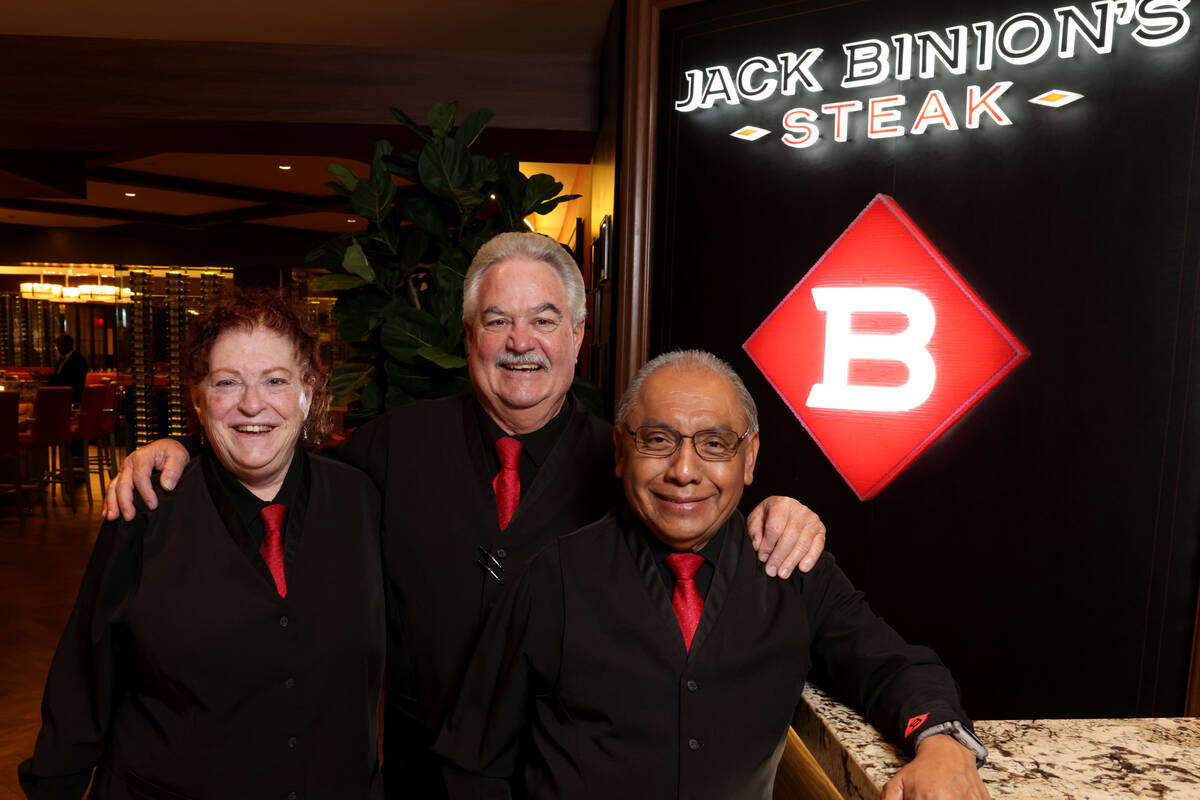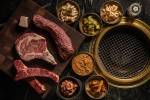Servers reveal secrets from 50 years at Strip steakhouse
When they walk into the dining room, Las Vegas dining history walks with them.
Jim Crossley and Hugo Izquierdo have worked in restaurants at Horseshoe Las Vegas (formerly Bally’s, formerly the MGM Grand) for nearly 49 years. Their colleague, Diane Burger, has done the job for 50 years come December.
Currently, they’re longtime servers at Jack Binion’s Steak, though they’ve worked in other restaurants at the property during their time.
They’ve made a good living: buying homes, putting themselves or children through college.
The careers of Crossley, Izquierdo and Burger began with (or soon after) Kirk Kerkorian opening the MGM Grand in 1973, then continued through the expansion of restaurant offerings at Strip properties, the deadly MGM fire in November 1980 that originated in a restaurant, the birth of megaresorts, the Vegas dining revolution of the late 1990s, the flourishing of celebrity chef restaurants, the brutal restaurant climate at the start of the pandemic, and the emergence of restaurants after COVID in a city where dining is more expensive than ever.
To relive and preserve a half-century of Vegas restaurant life, the Review-Journal sat down with the trio the other afternoon in Jack Binion’s Steak, which debuted as Barrymore’s steakhouse when the MGM Grand launched. The room became different steakhouses through the years, including Bally’s Steakhouse and BLT Steak. This Q&A session has been edited for length and clarity.
JIM CROSSLEY
Crossley started as a busser at the MGM deli in 1974; four months later, he was promoted to server. He joined Barrymore’s in 1978.
Review-Journal: What was Barrymore’s like?
Jim Crossley: We did 600 to 700 covers a night. Most of the food was comped at that time because casinos comped a lot of food back then. There were a lot of celebrities that came through: Barry Bonds, Cary Grant, Elizabeth Taylor. Charles Barkley was a good tipper. We served Chateaubriand, surf and turf back then. Dover sole. Rack of lamb. Abalone. We had a pretty good mixture.
RJ: How have diners changed?
JC: People used to dress for dinner. Now, they’re more in a hurry than they used to be. There were very rarely children. There were a lot of “father-daughters.” People don’t look for Chateaubriand anymore.
RJ: What’s the secret to being a waiter for almost 50 years?
JC: I like what I do. I treat people like they were in my own home. You have to “kiss” on your tables. You have to take care of your feet. I take a lot of vitamins and get massages.
HUGO IZQUIERDO
Izquierdo came to the MGM in 1974, straight out of high school in Reno. He worked as a busboy at Barrymore’s before being promoted to server. He left the restaurant to work for a stretch at Café Gigi, a French restaurant, then returned to the steakhouse.
Review-Journal: What are some restaurant memories from back in the day?
Hugo Izquierdo: There were cigarette girls. People came to dine, at least two hours. The were two different menus, one for men, one for women with no prices. It was only suit-and-tie and cocktail dresses. There were a lot of ladies of the evening. They were dining companions. I remember one man who stupidly let her go and cash his chips. She didn’t come back. People don’t dine anymore — they eat.
RJ: How has your uniform changed?
HI: At one time, we served with white gloves. It was kind of dark, the dining rooms — that’s how they could see me. We had to change them all the time. We would go through at least two or three pairs a day.
RJ: What are some skills that were once essential for a good server but no more?
HI: Making Caesar salad, flambéing foods and filleting Dover sole tableside.
DIANE BURGER
Burger started as a busser at the MGM deli in early December 1973 (opening day at the property). She was promoted to server around the same time as Crossley. Like Izquierdo, she worked at Barrymore’s, then for a time at Café Gigi, before returning to the steakhouse.
Review-Journal: When you came to the MGM, servers were overwhelmingly male. What was that like?
Diane Burger: I was the fourth woman to break the barrier. When I went into the steakhouse, I wore a brown vest and a jacket like an ice cream seller. I had a back waiter then. That’s changed. Sometimes, I worked as a hostess.
RJ: What’s a particularly vivid memory from Gigi’s?
DB: In those days, there were more couples in the restaurant. We had alcoves with drapes. During the porno convention, one couple got up and closed the drapes. My maître d’ didn’t like that.
RJ: Brunch is a thing right now in Vegas. Was that true in years past?
DB: Once upon a time, the steakhouse had a sterling brunch. It was $125 a person. We had a four-month waiting list.
RJ: You could have retired when the steakhouse closed at the start of the pandemic. Why did you return when it reopened more than two years later?
DB: They asked me that: “Why do you want to come back?” I said, “I miss my family.” We work like family.
Contact Johnathan L. Wright at jwright@reviewjournal.com. Follow @ItsJLW on Twitter.






























